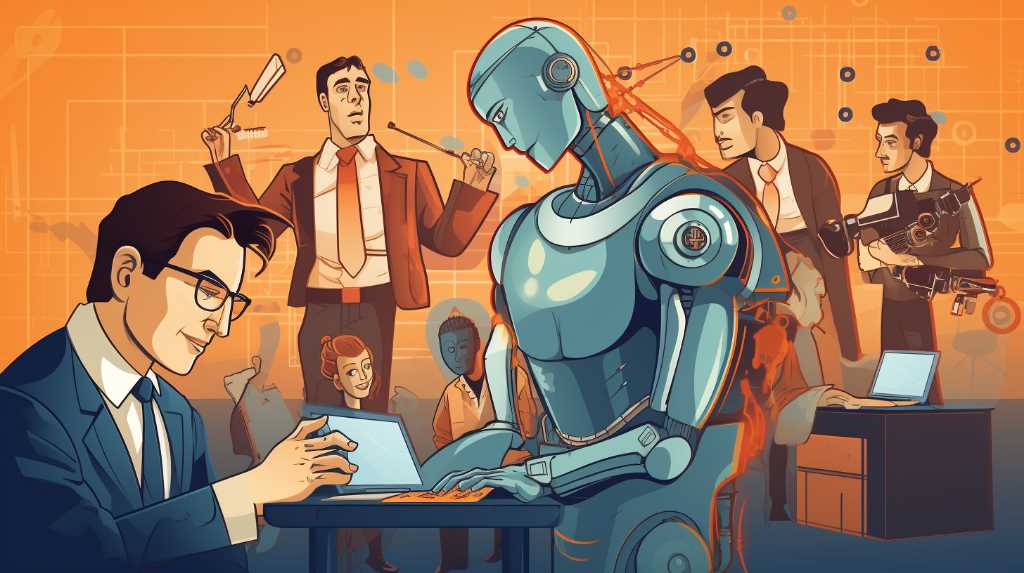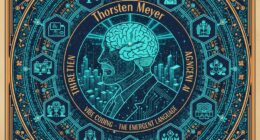Welcome to our comprehensive guide on machine learning, the incredible technology that is reshaping industries and revolutionizing problem-solving. In this article, we will explore the wonders of machine learning, its applications, and its role in today’s world. From artificial intelligence to data science, predictive analytics to natural language processing, we will delve into the fascinating realm of machine learning and deep learning.
Machine learning, at its core, enables computers to learn from data without explicit programming. It empowers computers with the ability to derive insights and predictions from complex datasets. By analyzing extensive data, recognizing patterns, and making informed decisions, machine learning has become an integral part of various industries.
Key Takeaways:
- Machine learning is revolutionizing problem-solving and reshaping industries.
- It enables computers to learn from data without explicit programming.
- Machine learning finds patterns, makes informed decisions, and derives insights.
- There are three types of machine learning: supervised, unsupervised, and reinforcement learning.
- Machine learning has diverse applications in data analysis, personalized experiences, healthcare advancements, autonomous systems, natural language processing, fraud detection, environmental monitoring, and financial analysis.
Understanding Machine Learning
Machine learning is a powerful technology that allows computers to learn patterns and make informed decisions without explicit programming. It revolutionizes problem-solving and has numerous applications across different industries. In this section, we will dive deeper into the fundamentals of machine learning, including data analysis, pattern recognition, decision-making, and algorithms.
Machine learning is based on the idea that computers can learn from data and improve their performance over time. It involves analyzing extensive datasets to uncover hidden patterns and relationships, which can then be used to make predictions or inform decision-making processes. By recognizing these patterns, machine learning algorithms can identify trends, classify data, and even generate new insights. This ability to extract valuable information from complex data sets makes machine learning an invaluable tool in today’s data-driven world.
Patterns and Decision-Making
Pattern recognition is a key aspect of machine learning. By detecting regularities and similarities in data, machine learning algorithms can identify patterns that may not be immediately apparent to humans. These patterns serve as the foundation for decision-making processes, allowing machines to make predictions, classify information, and solve complex problems. Algorithms used in machine learning are designed to continuously learn and improve, enabling them to adapt to new data and refine their decision-making abilities over time.
“Machine learning enables computers to learn from data without explicit programming.”
Algorithms play a crucial role in machine learning. They are the set of mathematical rules and instructions that enable machines to learn from data. These algorithms are applied to large datasets, which are divided into training and testing sets. The training set is used to teach the algorithm, while the testing set is used to evaluate its performance. By measuring the algorithm’s accuracy and adjusting its parameters, machine learning models can optimize their predictions and make more accurate decisions.

Conclusion
In conclusion, machine learning is a powerful technology that enables computers to learn from data, recognize patterns, and make informed decisions. It has revolutionized problem-solving and is widely used in various industries. Understanding the basics of machine learning, including data analysis, pattern recognition, decision-making, and algorithms, is essential for anyone looking to leverage its potential for innovation and growth.
Types of Machine Learning
In the world of machine learning, there are three main categories or types: supervised learning, unsupervised learning, and reinforcement learning. Each type serves a different purpose and utilizes specific algorithms to process and analyze data.
Supervised Learning
Supervised learning is a type of machine learning where the algorithm is trained using labeled examples. These examples consist of input data and the corresponding correct output or target variable. The algorithm learns to make predictions by mapping the input data to the correct output based on the provided labels.
This type of machine learning is often used for tasks such as classification and regression problems. Classification involves predicting a discrete label or category, while regression involves predicting a continuous numerical value. Examples of supervised learning algorithms include decision trees, support vector machines, and linear regression.
Unsupervised Learning
Unsupervised learning, on the other hand, does not require labeled data. Instead, the algorithm learns to find patterns or structures in unlabeled data. It explores the data and identifies similarities or clusters based on shared characteristics.
This type of machine learning is useful for tasks such as data exploration, clustering, and dimensionality reduction. It can help uncover hidden patterns or relationships in the data that may not be apparent to humans. Common algorithms used in unsupervised learning include clustering methods like k-means and hierarchical clustering, as well as dimensionality reduction techniques like principal component analysis (PCA) and t-distributed stochastic neighbor embedding (t-SNE).
Reinforcement Learning
Reinforcement learning is a type of learning where an agent learns to interact with an environment and improve its performance through trial and error. The agent receives feedback in the form of rewards or penalties based on its actions and learns to maximize the rewards over time.
This type of machine learning is often used in scenarios where the optimal decision-making strategy is not explicitly known. It has applications in areas such as robotics, game playing, and autonomous systems. Reinforcement learning algorithms, such as Q-learning and deep Q-networks (DQN), are designed to learn from the consequences of their actions and optimize their behavior accordingly.
| Type of Machine Learning | Definition | Examples |
|---|---|---|
| Supervised Learning | Algorithm trained using labeled examples | Decision trees, support vector machines, linear regression |
| Unsupervised Learning | Algorithm finds patterns in unlabeled data | K-means clustering, hierarchical clustering, PCA, t-SNE |
| Reinforcement Learning | Agent learns through trial and error based on rewards | Q-learning, deep Q-networks (DQN) |
Applications of Machine Learning
Machine learning has revolutionized industries and aspects of our lives. Its versatility and ability to derive insights from complex data have made it applicable in various domains. Let’s take a closer look at some of the key applications of machine learning:
Data Analysis:
Machine learning algorithms play a crucial role in data analysis. They can analyze large volumes of data, identify patterns, and extract valuable insights. This allows businesses to make data-driven decisions, optimize processes, and identify trends that lead to better performance and competitiveness.
Personalized Experiences:
Machine learning enables personalized experiences in numerous industries. From recommendation engines that suggest products or content based on user preferences, to personalized marketing campaigns that target specific audiences, machine learning algorithms can analyze vast amounts of data to deliver tailored experiences that enhance customer satisfaction and engagement.
Healthcare Advancements:
Machine learning has the potential to revolutionize healthcare. From diagnosing diseases to predicting patient outcomes, machine learning algorithms can analyze medical data and provide valuable insights to healthcare professionals. This can lead to more accurate diagnoses, personalized treatment plans, and improved patient outcomes.
Autonomous Systems:
Machine learning is the driving force behind autonomous systems such as self-driving cars and drones. These systems use machine learning algorithms to analyze real-time data and make decisions in complex environments. Machine learning enables these systems to learn from their experiences and continuously improve their performance, making them more efficient and safer.
Natural Language Processing:
Machine learning is at the core of natural language processing (NLP) technology. NLP enables computers to understand and interpret human language, making it possible to build chatbots, voice assistants, and language translation systems. Machine learning algorithms can analyze vast amounts of textual data, extract meaning, and respond to user queries with high accuracy.
Fraud Detection:
Machine learning algorithms are widely used in fraud detection systems. By analyzing patterns and anomalies in large datasets, machine learning algorithms can identify suspicious activities and detect fraudulent transactions in real-time. This helps businesses prevent financial losses and protect their customers from fraudulent activities.
Environmental Monitoring:
Machine learning algorithms are used in environmental monitoring systems to analyze sensor data and detect patterns related to pollution levels, climate change, and natural disasters. By analyzing this data, machine learning algorithms can provide valuable insights that help in environmental conservation and decision-making.
Financial Analysis:
Machine learning algorithms are increasingly being used in financial analysis and trading. These algorithms can analyze market data, identify trends, and make predictions about stock prices and market movements. This enables financial institutions and traders to make informed decisions and optimize their investment strategies.

| Application | Description |
|---|---|
| Data Analysis | Machine learning algorithms analyze large volumes of data to extract valuable insights and drive data-driven decision-making. |
| Personalized Experiences | Machine learning enables businesses to deliver personalized experiences by analyzing user data and making tailored recommendations. |
| Healthcare Advancements | Machine learning algorithms in healthcare analyze medical data to improve diagnoses, treatment plans, and patient outcomes. |
| Autonomous Systems | Machine learning powers autonomous systems like self-driving cars that can make decisions based on real-time data and learn from their experiences. |
| Natural Language Processing | Machine learning is at the core of NLP technology, enabling computers to understand and respond to human language. |
| Fraud Detection | Machine learning algorithms identify patterns and anomalies to detect fraudulent activities and protect businesses and customers. |
| Environmental Monitoring | Machine learning helps analyze sensor data for environmental conservation and decision-making. |
| Financial Analysis | Machine learning algorithms analyze market data to make predictions and optimize investment strategies. |
Role of Machine Learning in Today’s World
In today’s data-driven world, machine learning plays a pivotal role in transforming industries and improving various aspects of our lives. With its ability to analyze vast amounts of data, machine learning enables us to gain valuable insights, provide personalized experiences, advance healthcare, drive autonomous systems, power natural language processing, enhance fraud detection and cybersecurity, facilitate environmental monitoring and conservation, and improve financial analysis and trading.
Data analysis is a critical application of machine learning, allowing organizations to extract meaningful information and make data-driven decisions. By leveraging machine learning algorithms, businesses can uncover hidden patterns and trends in data, leading to more accurate predictions and improved decision-making processes. This empowers companies to optimize their operations, identify new opportunities, and stay ahead of the competition.
Machine learning also enables personalized experiences, ranging from tailored recommendations on e-commerce platforms to customized user interfaces in various applications. By analyzing user data and behavior patterns, machine learning algorithms can deliver personalized content, products, and services that cater to individual preferences and needs. This enhances user satisfaction, engagement, and loyalty, ultimately driving business growth.
In the healthcare industry, machine learning has the potential to revolutionize patient care and outcomes. By analyzing medical records, images, and genetic data, machine learning algorithms can assist in diagnosing diseases, predicting treatment outcomes, and identifying potential healthcare risks. This not only improves the accuracy and efficiency of medical diagnoses and interventions but also helps healthcare providers deliver personalized and targeted treatments to patients.
In conclusion, machine learning has emerged as a technology that has far-reaching implications in various domains. Its capabilities in data analysis, personalized experiences, healthcare advancements, autonomous systems, natural language processing, fraud detection, environmental monitoring, and financial analysis make it a powerful tool for innovation and progress. As we continue to explore and harness its potential, machine learning will continue to shape the future and drive transformative changes in our world.
Introduction to Deep Learning: What is it and why is it important?
Deep learning, a subset of machine learning, is a powerful technique that utilizes artificial neural networks to model high-level abstractions in data. It has emerged as a game-changer in the field of artificial intelligence, enabling machines to learn from experience, understand the world, recognize complex patterns, and make accurate predictions.
At its core, deep learning involves training neural networks with vast amounts of data, allowing them to automatically learn from the data and extract meaningful insights. This approach has revolutionized various domains, including image recognition, natural language processing, self-driving cars, and robotics. Deep learning algorithms have achieved unprecedented levels of accuracy and performance in these areas, surpassing traditional machine learning methods.
The importance of deep learning lies in its ability to tackle complex problems and generate powerful predictions. By leveraging its neural network architecture, deep learning excels at identifying intricate patterns and relationships in complex datasets. This capability has paved the way for groundbreaking advancements in areas such as medical diagnosis, predictive analytics, customer behavior analysis, and more.
As the demand for intelligent systems continues to grow, deep learning plays a crucial role in enabling machines to understand and process vast amounts of data efficiently. Its applications extend beyond traditional data analysis, empowering industries to make informed decisions, automate processes, enhance user experiences, and drive innovation. By harnessing the power of deep learning, organizations can unlock new possibilities and gain a competitive edge in the digital era.

Key Takeaways:
- Deep learning is a subset of machine learning that uses artificial neural networks to model high-level abstractions in data.
- It enables machines to learn from experience, understand the world, recognize patterns, and make accurate predictions.
- Deep learning has revolutionized domains such as image recognition, natural language processing, self-driving cars, and robotics.
- Its ability to identify complex patterns and relationships in data makes it crucial for solving complex problems and generating powerful predictions.
- Deep learning empowers industries to automate processes, enhance user experiences, and drive innovation.
Conclusion
Machine learning and deep learning are transformative technologies that are shaping industries and improving our daily lives. With their wide range of applications, these technologies are revolutionizing how we analyze data, personalize experiences, advance healthcare, drive autonomous systems, enhance fraud detection and cybersecurity, facilitate environmental monitoring and conservation, and improve financial analysis and trading.
As we look towards the future, the potential for machine learning and deep learning is limitless. The ability to extract insights and predictions from complex data opens up new possibilities for innovation and growth. By understanding the basics of these technologies, individuals and organizations can harness their power to drive progress and stay ahead in an increasingly data-driven world.
To dive deeper into the fascinating world of machine learning and deep learning, explore the resources provided. Discover how these technologies are reshaping industries, learn about the latest advancements, and stay updated on the future trends and possibilities. Embrace the opportunities that machine learning and deep learning offer, and unlock the magic of data-driven decision-making.
FAQ
What is machine learning?
Machine learning is a cutting-edge technology that enables computers to learn from data without explicit programming. It revolutionizes problem-solving and is reshaping various industries with its ability to derive insights and predictions from complex data.
How does machine learning work?
Machine learning allows computers to learn patterns from data without explicit programming. It works by analyzing extensive datasets, recognizing hidden patterns, and making informed decisions. This approach has revolutionized problem-solving and made computers intelligent partners in various industries.
What are the types of machine learning?
Machine learning can be categorized into three types: supervised learning, unsupervised learning, and reinforcement learning. Supervised learning involves training algorithms with labeled examples, unsupervised learning finds patterns in unlabeled data, and reinforcement learning teaches algorithms through rewards and penalties. These three types serve different purposes and have diverse applications.
How is machine learning applied in various industries?
Machine learning has revolutionized industries and aspects of our lives. It is used for data analysis, personalization, healthcare advancements, autonomous systems (such as self-driving cars), natural language processing, fraud detection, environmental monitoring, and financial analysis. The versatility of machine learning algorithms makes them applicable in various domains.
What is the role of machine learning in today’s world?
Machine learning plays a crucial role in today’s world. It enables data analysis and insights, provides personalized experiences, advances healthcare, drives autonomous systems, powers natural language processing, enhances fraud detection and cybersecurity, facilitates environmental monitoring and conservation, and improves financial analysis and trading.
What is deep learning and why is it important?
Deep learning is a subset of machine learning that uses artificial neural networks to model high-level abstractions in data. It enables machines to learn from experience, understand the world, recognize patterns, and make predictions. Deep learning is important because it has revolutionized tasks like image recognition, natural language processing, self-driving cars, and robotics.
How do machine learning and deep learning reshape industries and our lives?
Machine learning and deep learning are transformational forces reshaping industries and making our lives more convenient and efficient. They have a wide range of applications and hold exciting possibilities for the future. Understanding their basics empowers individuals and organizations to harness their potential for innovation and growth.
Source Links
- https://medium.com/@agarwal_pulkit/a-beginners-guide-to-machine-learning-unveiling-the-magic-of-smart-computers-2863ba9220b8
- https://medium.com/@duttaanubrata12/machine-learning-unveiling-the-magic-behind-intelligent-algorithms-e0c9cf2309fc
- https://www.krishlogy.com/post/unveiling-the-magic-of-deep-learning-a-step-by-step-guide











